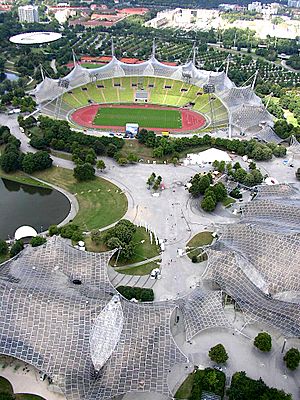Frei Otto facts for kids
Quick facts for kids
Frei Otto
|
|
|---|---|
| Born |
Frei Paul Otto
31 May 1925 Siegmar, Germany
|
| Died | 9 March 2015 (aged 89) Warmbronn, Germany
|
| Nationality | German |
| Occupation | Architect |
Frei Paul Otto (born May 31, 1925 – died March 9, 2015) was a famous German architect and engineer. He was known for designing buildings with very light structures. These often included special "tensile" and "membrane" structures. Think of them like giant tents or stretched fabrics.
One of his most famous designs is the roof of the Olympic Stadium in Munich. This stadium was built for the 1972 Summer Olympics. Otto received the Royal Gold Medal in 2006. He was also given the Pritzker Architecture Prize in 2015, just before he passed away.
Contents
Early Life and Inspirations
Frei Otto was born in Siegmar, Germany. He grew up in the city of Berlin. He started studying architecture in Berlin. However, he was drafted into the German air force (Luftwaffe) during World War II. He served as a fighter pilot.
After the war, he was held in a prisoner of war camp in France. There, he used his engineering skills to experiment with tents. He needed to build shelters quickly with limited materials. This experience shaped his future ideas about lightweight buildings. Later, he traveled to the United States. He met famous architects like Erich Mendelsohn and Frank Lloyd Wright.
Designing Lightweight Structures
Otto started his own architecture business in Germany in 1952. He earned a special degree in "tensioned constructions" in 1954. His first big project was a music pavilion in Kassel in 1955. It had a unique saddle-shaped roof made of cables.
Frei Otto became an expert in lightweight structures. These included "tensile" (stretched) and "membrane" (fabric-like) designs. He helped create new ways to use math and engineering for these types of buildings. In 1964, he started an institute for lightweight structures. This was at the University of Stuttgart. He led this institute until he retired.
Some of his most important works include the West German Pavilion at the Montreal Expo in 1967. Another major project was the roof for the 1972 Munich Olympic Arena. He also taught at the Architectural Association School of Architecture.
Otto continued to work as an architect and engineer until he died. He advised other architects on projects in the Middle East. He also worked with Shigeru Ban on the Japanese Pavilion for Expo 2000. This pavilion had a roof made entirely of paper.
In 2002, Otto shared an idea to remember the September 11 attacks. He imagined covering the footprints of the World Trade Center buildings with water. Trees would surround them.
Frei Otto passed away on March 9, 2015. He was supposed to be announced as the winner of the 2015 Pritzker Architecture Prize later that month. But because of his death, the award was announced early. He had already been told he won. He reportedly said he was "very happy" and that he tried to help "poor people."
Notable Buildings and Projects
Here is a list of some buildings designed by Frei Otto:
- 1957 – Tanzbrunnen pavilion in Rheinpark, Cologne, Germany
- 1967 – West Germany Pavilion at Expo 67, Montreal, Canada
- 1972 – Roof for Olympic Stadium, Munich, Germany
- 1974 – Convention Center in Mecca, Saudi Arabia
- 1975 – Multihalle, Mannheim, Germany
- 1977 – Umbrellas for the 1977 Pink Floyd tour
- 1980 – Aviary at Munich Zoo, Germany
- 1985 – Tuwaiq Palace, Saudi Arabia, with Buro Happold
- 1987–91 – Housing at the International Building Exhibition Berlin, Germany
- 2000 – Roof structure of the Japanese Pavilion at Expo 2000, Hanover, Germany (with Shigeru Ban)
-
Multihalle in Mannheim
Awards and Recognition
Frei Otto received many important awards for his work:
- 1974 – Thomas Jefferson Medal in Architecture
- 1980 – Honorary degree from the University of Bath
- 1996/97 – Wolf Prize in Architecture
- 2005 – Royal Gold Medal for architecture by RIBA
- 2006 – Praemium Imperiale in Architecture
- 2015 – Pritzker Architecture Prize
See also
 In Spanish: Frei Otto para niños
In Spanish: Frei Otto para niños
- Gridshell





